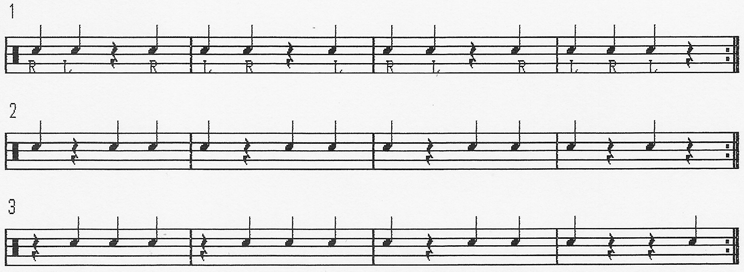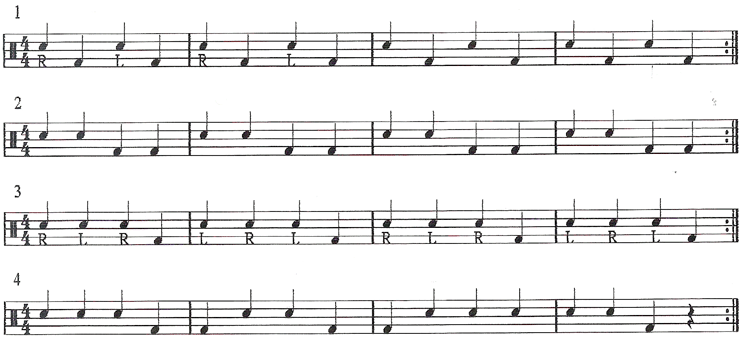Navigate to:

Navigate to: |
HOME | 
| BACK TO TUITION PAGE |
|---|
New students often say to me "I bought a book, but I couldn't get on with it - it was so Boring! So often I'll ask the kind of thing the book was about and once they've given me a rough idea, I sit behind the kit and play. "Yeah" they say "That's the kind of drumming I want to be able to play." My usual reply is: "All that I've just played was what you described from your book, only I played the whole kit and used a bit of creativity and imagination".
I find a great way to motivate yourself to learn is to remove the boring factor. You can do this by experimenting with exercises, making them more interesting and personal to you. Obviously before you can experiment you need to get the exercise down, but now you have the motivation for putting in the work required.
But how do you learn to get creative and personalise stuff? First you need to establish a framework around which you can be creative. For me this framework is time, and it is the most basic skill required from you by all the other musicians who will play with you. If you can play good "time" (without speeding up or slowing down as many bad drummers do) and also be "creative" around that time-base, you're on a path to success on the drums.
Another essential quality we need to develop is the ability to think like a drummer! So much of the skill of playing drums is in the head; co-ordination after all is really a question of how well the mind and body communicate. If we create good routes of communication between mind and body its only a matter of physical practice to then transfer our thoughts to the kit.
I hope you enjoy the following exercises which I have designed to get new drummers started on the right path. While you start out on your drumming journey try to keep these four thoughts in mind:
An area that many drummers worry about is "reading", but trust me - its easy if you go about it the right way. We are going to start with the most basic, but still important notes that we play. Remember that the secret of drumming is in your head, and its future is in your hands!
Quarter notes are easy to recognise as they are simply a solid black base and a stem.
Notes tell us to play something! Each note has another sign related to it, and this is called a Rest. All a "rest" does is tell us Not to play something, and leave a space instead of playing a note.
Sticking: This is an R or an L to tell us which hand should strike.

If there is no sticking shown we play "Hand To Hand", which means whatever hand you used to play the last strike, use the other hand to play the next one. Don't worry if the next sign is a rest, just go to the other hand next time you play a note.
For the following examples we will count from 1 to 4 we play them as evenly as we can as (think of the ticking of a clock). This is called "counting pulse, as quarter notes are often known as "Pulse Beats.
The sticking for the first exercise has been provided for you and you will notice that the example finishes on the left hand. At the end of the exercise there are two "dots" which tell us to repeat the exercise. This means that when we return to the start for the second "lap" of the repeat our hand to hand theory will tell us to restart the exercise with the Right hand. If that last note had been a Right however, we would restart from the Left hand.
Examples 2 and 3 have no sticking written so you must work out the hand to hand sticking for yourself. After a short while it will become a very natural way to play an exercise. This is the way we will try to play as often as we can as it makes both of your hands do an equal amount of work.

Did you manage to maintain a steady count all the way through the excercises? Good if you did, but if you found it awkward it may take a bit more practice to get comfortable with counting accurately in time. It takes every brain a different amount of time to become A) comfortable counting and playing at the same time and B) able to fully appreciate what an essential skill this is.(It took a while before it made sense to me!)
Now that we know how Quarter notes and rests work we need to take a brief look at an important bit of theory. We don't want to get bogged down in theory but for a drummer this is a big one!
Time Signatures are possible more important to a drummer than to other players. They tell us about the Pulse of the music, and drums are the pulse instrument of the band!!
Time Signatures tell us two vital pieces of information via A) the upper number and B) the bottom number.


This means that in the illustration above the upper number tells us that each bar that follows it must have 4 pulse beats, but the bottom number is telling us that each pulse will be the the value (or duration) of a quarter note. This time signature is often called Four Four. All of the examples in this "getting started" section will be in "Four Four" as this is the most common time signature in modern use; so common in fact that it is often referred to as Common Time and the two numbers replaced by the letter C (See example below.)


Now we have a better idea of what a Time Signature does we can get on with the drumming!
In the next exercises we will play quarter notes in a different way. Instead of "Hand to Hand" style we will write each hand on a different line. Right handed players will use that hand to play the upper line but left handers will use that hand to do the job. We will still count in just the same way as we did in the previous examples, but this time we will be reading the two lines at the same time! As soon as you feel comfortable reading the two lines as one you are ready to play the top line on HiHat and the lower line on the Snare drum. Notice that the HiHat notes have an "X" instead of the normal round solid base.
A hihat is capable of producing a great variety of different sounds so for getting started I reccomend that you set a gap between the cymbals of about 1 inch, and then keep it fairly firmly closed using foot pressure (Traditionally for a right handed player this would be from your left foot).
In the first exercise at beat "One" we have notes in both the upper and lower lines. This means that as you count "One" you will strike both closed hihat and snare. As we count "Two" we have a note in the upper line and a rest (telling us not to play) in the lower. So as we count "Two" we are only going to play the hihat with our main hand (often known as our riding hand). On the count of "Three" we play both hands again and the riding hand only on "Four". As you will see there are "repeat dots" at the end of each line. These dots are telling us to go back to the start and play the exercise again (its good practice to repeat these exercises as many times as you feel like!).

Now we are going to play some quarter notes using the Bass Drum. The Bass Drum is written in the bottom space of the Staff (the five lines on which our music is written), and the snare in the space above the middle line. Use your pulse count to make sure that all of the quarter notes are played in the same regular time. Always be aware that a bass drum quarter note last the same amount of time as a snare drum quarter note. They're just quarter notes that make us produce a different sound!

Once we have these smooth and accurate we are ready to put HiHat, Snare and Bass Drum together. Remember that the hihat is usually written just above the staff (although over the years I've seen it written in a few odd places!). In the first exercise we see that we have to play a closed hihat and a bass drum as we count pulse "1". On pulse "2" we play a hihat and a snare, and on three a hihat and bass drum and so on through the line. Use your pulse count to develop an even "feel" right through each exercise. Soon they will become easy to play and you're on the road to becoming a drummer!

